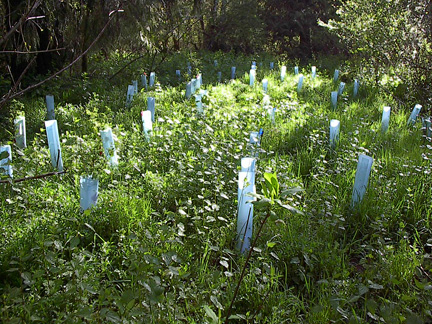
Bontrager |
This project contains plantings of various ages, ranging back nearly 15 years. We are monitoring only the most recent plantings, some installed winter of 2005, and others winter of 2006. Dave Bontrager has been doing riparian restoration on his property since he purchased the land 14 years ago. This current planting is only one stage of all of the work he has been doing. The estuary that runs through his property runs into Lost Creek, which is part of the Watershed of the Middle Fork of the Willamette River. Dave Bontrager’s primary goal is to increase the species diversity, particularly of birds, on his property.

Mature planting of willows.

Logs placed in the stream to divert high water and disperse energy.

A similar log jam placed to slow down fast water.

One of the plots at Bontrager's.
Bontrager Data
Species |
2005 Average Height Class |
2006 Average Height Class |
2007 Average Height Class |
% Change 05-06 |
% Change 06-07 |
% Change 05-07 |
||
Osoberry |
0.5 |
1.6 |
1.8 |
220.0% |
12.5% |
260.0% |
||
Pacific Ninebark |
2.0 |
1.2 |
1.5 |
-40.0% |
25.0% |
-25.0% |
||
Wild Rose |
1.3 |
1.9 |
1.8 |
46.2% |
-5.3% |
38.5% |
||
Willow |
1.8 |
1.8 |
2.0 |
0.0% |
11.1% |
11.1% |
||
Spirea |
0.7 |
2.1 |
1.5 |
200.0% |
-28.6% |
114.3% |
||
Snowberry |
2.1 |
2.2 |
1.9 |
4.8% |
-13.6% |
-9.5% |
||
Species |
2006 Live Plant Count |
2007 Live Plant Count |
% Survival 06-07 |
Red Alder |
1 |
1 |
100.0% |
Osoberry |
5 |
5 |
100.0% |
Pacific Ninebark |
11 |
11 |
100.0% |
Wild Rose |
8 |
7 |
87.5% |
Willow |
4 |
1 |
25.0% |
Spirea |
28 |
28 |
100.0% |
Snowberry |
12 |
12 |
100.0% |